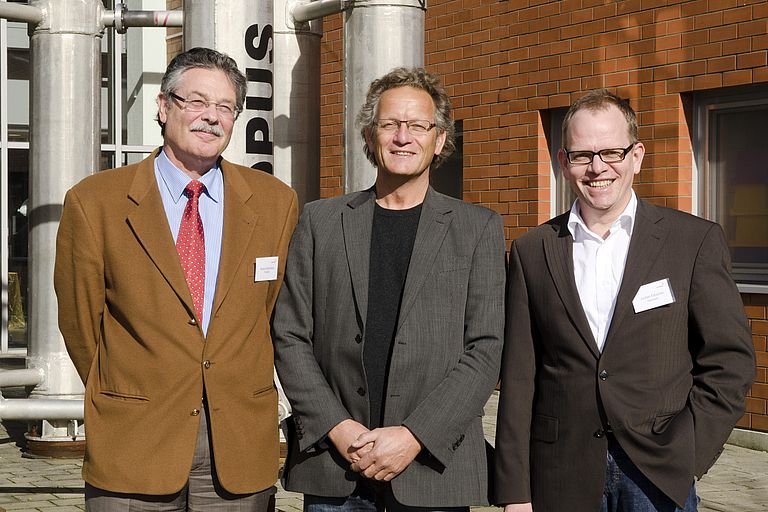Drilling Deep to Understand the Earth
Over 200 geoscientists planning projects for the future in Kiel
Almost exactly one year ago, on March 11, 2011 the earth quaked on the eastern coast of the Japanese island Honshu The tsunami that followed claimed 15,000 lives, large parts of the main Japanese island were destroyed. As a result of the destruction several atomic power plants failed, the most serious in the Fukushima power plant. Although the danger of earthquakes is known in Japan, the intensity of the quake surprised geoscientists around the world. Coastal regions further south had been thought to be much more in danger. “This is a good example of how incomplete our knowledge about processes in the Earth’s interior still is.”, says the Geologist Prof. Jan Behrmann of GEOMAR | Helmholtz Centre for Ocean Research Kiel.
Gaining insights into the Earth’s interior is extremely complicated. The only possibility for taking direct samples is scientific drilling, which requires however a very complex and costly technology. For this reason geoscientists joined together years ago in the International Continental Drilling Program (ICDP) and the Integrated Ocean Drilling Program (IODP) in order to elicit the secrets of the Earth’s interior all over the globe, on land and under the sea. From March 7th to 9th 2012 more than 200 geoscientists from all of Germany as well as many guests from abroad have come to Kiel for the German IODP-ICDP colloquium at GEOMAR to discuss the results of previous drilling campaigns and plan future activities with ICDP and IODP.
These involve – especially in light of the one year anniversary of the Japanese earthquake – of course earthquakes and plate tectonics. The Kiel geoscientists reported on an expedition in 2011 with the American drilling ship JOIDES RESOLUTION during which they investigated an earthquake zone off the coast of Costa Rica. But with scientific drilling scientists want to answer other questions as well, for example, on global climate changes, on the geological history of the Earth or the origin of life on our planet. “Deep drilling is basic research which has already remarkably increased our understanding of the Earth system and in future it will continue to do so”, emphasizes Behrmann.
Before the colloquium the German Research Drilling Consortium (GESEP) is organizing a two day event for students, PhDs and young scientists. The GESEP School 2012 is dedicated to new concepts for usage of the subsurface. Here the emphasis is mainly on the use of geothermal energy, shale gas and methane hydrates as well as questions about CO2 sequestration.
German participation in IODP and ICDP is financed within the framework of the priority programs of the German Science Foundation (DFG)
Background information
Integrated Ocean Drilling Program (IODP)
Earthquakes, volcanic activity, plate tectonics – the planet on which we live is very active and an extremely complex system. In order to find out more about the dynamics of the Earth‘s crust under the oceans and how it functions over 20 nations joined forces in 2003 lead by the USA, Japan and a European consortium in the Integrated Ocean Drilling Program (IODP). This was a continuation of the Ocean Drilling Program (ODP) started in 1985. With the help of deep drilling in the ocean’s crust the scientists hope to unravel several essential mysteries of the Earth. The main research equipment comprises the 143 meter long American drilling ship JOIDES RESOLUTION and the 210 meter long Japanese drilling ship CHIKYU. The latter was damaged slightly during the tsunami on March 11, 2011, but is meanwhile again being used for research.
International Continental Drilling Program (ICDP):
ICDP is a land-based drilling program in which questions about natural catastrophes, volcanic activity, earthquakes and climate change are being investigated. ICDP is based on an international consortium of 22 nations, the UNESCO and the company Schlumberger. It is an internationally lead geoscientific program that deals with fundamental geoscientific problems of global importance. In ICDP these problems are carefully researched by international teams of scientists in carefully selected locations. The program represents all the geosciences and is internationally and nationally evaluated.
The main difference between the IODP and the ICDP programs is that the ICDP programs are supported using mixed financing and the costs are distributed internationally among the project participants. Each individual drilling project is independently organized as a “joint venture” between ICDP and the project leaders: land-based drilling allows a significantly greater diversity in the drilling locations and depths and thus also the drilling technologies. Continental geography is known in much more detail than that of the oceans. For this reason the financers must be convinced, that a complicated drilling campaign is absolutely necessary for the relevant project.
High-res images
Contact:
Jan Steffen (Communication & Media), Phone: +49-431 600 2811, presse(at)geomar.de
![[Translate to English:] Die 143 Meter lange JOIDES RESOLUTION 2011 im Hafen von Puntarenas (Costa Rica). Sie ist neben der japanischen CHIKYU die wichtigste Forschungsplattform des IODP Foto: S. Kutterolf, GEOMAR he 143 meter long JOIDES RESOLUTION 2011 in the harbor of Puntarenas (Costa Rica). It is – along with the Japanese CHIKYU – the most important research platform of the IODP Image: S. Kutterolf, GEOMAR](/fileadmin/_processed_/1/9/csm_2011-03-15_01_JoidesResolution-Puntarenas_SKutterolf-IFM-GEOMAR_be0f7ca879.jpg)



